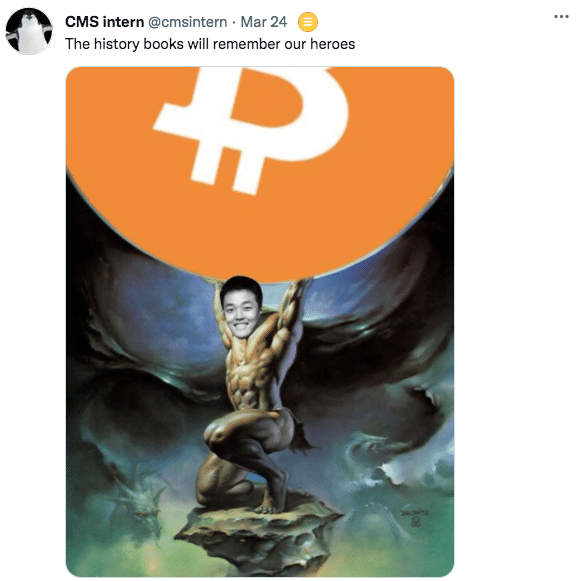March 28, 2022 / Unchained Daily / Laura Shin
Daily Bits ✍️✍️✍️
-
Coinbase users sending crypto outside their Coinbase accounts in Canada, Singapore, and Japan will soon have to identify personal information of the person/entity they are sending to.
-
Kraken hit a crucial milestone in gaining a Fed account (which would give it equal treatment to traditional banks).
-
US Treasury Secretary Janet Yellen made a constructivecomment about crypto last week.
-
The UK is set to publish plans for regulating crypto in the next few weeks.
-
An ApeCoin branded Twitter scam led to $1 million in stolen funds.
-
Cool Cats, an Ethereum NFT project, signed with CAA for licensing and merchandising opportunities.
-
Anchor is now the largest DeFi lending protocol.
-
XCOPY raised $24 million in minutes from their latest NFT drop.
-
Indians will soon begin paying a 30% tax on crypto gains.
- The Bank of Japan is moving into the second phase of its CBDC experiment.
Today in Crypto Adoption…
-
Ukraine will be launching an NFT museum this week.
- New York Senator Kirsten Gillibrand and Wyoming Senator Cynthia Lummis are working together on a bill that promises to clarify regulations for crypto.
The $$$ Corner…
-
Avalanche Foundation and Op3n announced a $100 million fund to bring creators to Avalanche.
What Do You Meme?
What’s Poppin’?
Remembering Hal Finney
Hal Finney was a Cypherpunk and bitcoin pioneer. He receivedthe first BTC transaction from Satoshi Nakamoto in 2009 and might have been the first person besides Satoshi to run Bitcoin, the software.
In March of 2013, roughly nine years ago, Hal took to Bitcointalk, an online forum for bitcoiners, to share his story.
Hal came across Bitcoin in 2009, as he was on Satoshi’s original mailing list. He was immediately intrigued. “I’ve noticed that cryptographic graybeards (I was in my mid 50’s) tend to get cynical. I was more idealistic; I have always loved crypto, the mystery and the paradox of it. When Satoshi announced Bitcoin on the cryptography mailing list, he got a skeptical reception at best. Cryptographers have seen too many grand schemes by clueless noobs. They tend to have a knee-jerk reaction. I was more positive,” wrote Hal in 2013.
From there, Hal got Bitcoin up and running – but forgot about it until late 2010, when he noticed bitcoins started to have real monetary value. However, by then, Hal had been handed a terrible diagnosis. Wrote Finney, “My body began to fail. I slurred my speech, lost strength in my hands, and my legs were slow to recover. In August, 2009, I was given the diagnosis of ALS, also called Lou Gehrig’s disease, after the famous baseball player who got it.”
By 2013, Hal was “essentially paralyzed.” He explained, “I am fed through a tube, and my breathing is assisted through another tube. I operate the computer using a commercial eyetracker system. It also has a speech synthesizer, so this is my voice now. I spend all day in my power wheelchair. I worked up an interface using an arduino so that I can adjust my wheelchair’s position using my eyes.”
Despite the state of his body, however, he continued writing code and, as of 2013, was working on a system to “harden” Bitcoin wallets. Tragically, Hal passed away in August of 2014.
However, as many have pointed out in the past week, Hal was able to leave a lasting – and prescient – touch on the Bitcoin community.
Notably, Hal predicted two of the biggest trends in crypto far before they were invented.
In December of 2010, for example, Hal envisioned a world in which Bitcoin was not used for payments. Instead, Hal thought Bitcoin’s fate would be to act as collateral for banks and other currencies.
“I believe this will be the ultimate fate of Bitcoin, to be the “high-powered money” that serves as a reserve currency for banks that issue their own digital cash. Most Bitcoin transactions will occur between banks, to settle net transfers. Bitcoin transactions by private individuals will be as rare as… well, as Bitcoin based purchases are today.”
Nine years later, Terraform Labs founder Do Kwon is making Hal’s theory a reality, using BTC as “high-powered money” to help stabilize the $16 billion algorithmic stablecoin UST.
Even more impressively, Hal predicted the NFT boom all the way back in 1993 – almost 25 years before the first CryptoKitty was minted.
While he nailed predictions regarding Bitcoin as a reserve currency and the rise of NFTs, the jury is still out on one of Hal’s most famous thought experiments.
“As an amusing thought experiment, imagine that Bitcoin is successful and becomes the dominant payment system in use throughout the world. Then the total value of the currency should be equal to the total value of all the wealth in the world. Current estimates of total worldwide household wealth that I have found range from $100 trillion to $300 trillion. With 20 million coins, that gives each coin a value of about $10 million.”
Recommended Reads
-
Raoul Pal on Bored Apes:
-
Arca’s Nick Hotz on blockchains and trust:
-
Forbes on Olaf Carlson-Wee:
On The Pod…
The Chopping Block: Do Kwon Pitches a Decentralized NFT Publishing Service
Welcome to The Chopping Block! Crypto insiders Haseeb Qureshi, Tom Schmidt, and Robert Leshner chop it up about the latest news in the digital asset industry. On this week’s episode, Do Kwon, founder of Terraform Labs, also dropped by. Show topics:
-
why Do decided to make millions of dollars in bets that LUNA will appreciate in value next year
-
what Robert and Do, as crypto/DeFi founders, think about Crypto Twitter
-
how the difficulty of building payment systems led to Do launching Terra
-
Gauntlet’s recent funding round (and what it does)
-
takeaways from Yuga Labs purchasing CryptoPunk and Meebits IP, ApeCoin, Otherside, and more
-
how NFTs could change the game publishing and content IP industries
-
whether an NFT collection’s cultural relevance is similar to an L1’s TVL
-
Bored Ape Yacht Club as the first NFT franchise
-
why Haseeb is so disappointed with Axie Infinity, VCs, and other P2E games
-
what Facebook’s foray into NFTs might look like
Book Update
My book, The Cryptopians: Idealism, Greed, Lies, and the Making of the First Big Cryptocurrency Craze, which is all about Ethereum and the 2017 ICO mania, is now available!
You can purchase it here: http://bit.ly/cryptopians




